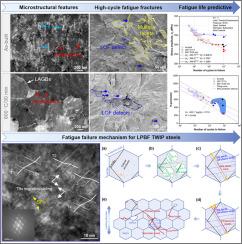High-cycle fatigue behaviors of twinning-induced plasticity steels fabricated by laser powder bed fusion
IF 14.3
1区 材料科学
Q1 MATERIALS SCIENCE, MULTIDISCIPLINARY
引用次数: 0
Abstract
Twinning-induced plasticity (TWIP) steels fabricated by laser powder bed fusion (LPBF) were subjected to heat treatments at 400°C for 1 h and 800°C for 30 min, followed by high-cycle fatigue (HCF) testing. The results reveal that, despite the high static strength achieved in LPBF TWIP steels, their fatigue strength remains relatively low. The heat treatments improved fatigue resistance by relieving residual stresses and/or disrupting cellular structures, particularly under low stress amplitudes. A predictive H-parameter model was proposed by integrating defect size, location, circularity, along with a weighting factor (h), to evaluate fatigue life under various conditions. In the as-built condition, decreasing stress amplitude caused a transition in crack initiation modes from surface lack-of-fusion (LOF) defects to internal {111} slip planes governed by microstructural features. The latter involves the activation of multiple slip systems with maximum Schmid factors exceeding 0.4 along the crack path, driven by the inhibition of dislocation motion by cellular structures. This promotes strong interactions among nano-twins and stacking faults (SFs) within multiple active slip systems, leading to localized stress concentrations at these intersections and twin boundaries. In addition, both low-angle grain boundaries (LAGBs) and cellular structures may hinder intragranular crack propagation and contribute to crack deflection.

激光粉末床熔合制备孪晶塑性钢的高周疲劳行为
采用激光粉末床熔合(LPBF)制备孪生诱导塑性(TWIP)钢,对其进行400℃1 h和800℃30 min的热处理,然后进行高周疲劳(HCF)试验。结果表明,尽管LPBF - TWIP钢具有较高的静强度,但其疲劳强度仍然相对较低。热处理通过消除残余应力和/或破坏细胞结构来提高抗疲劳性,特别是在低应力幅值下。通过综合缺陷尺寸、位置、圆度以及加权系数h,提出了一种预测h参数模型,以评估不同条件下的疲劳寿命。在原状条件下,应力幅值的减小导致裂纹起裂模式从表面缺乏熔合(LOF)缺陷转变为由微观组织特征控制的内部{111}滑移面。后者涉及激活沿裂纹路径的多个滑移系统,最大施密德因子超过0.4,由细胞结构抑制位错运动驱动。这促进了多个活动滑动系统中纳米孪晶和层错(SFs)之间的强相互作用,导致这些交叉点和孪晶边界的局部应力集中。此外,低角晶界和胞状结构都可能阻碍裂纹扩展,导致裂纹偏转。
本文章由计算机程序翻译,如有差异,请以英文原文为准。
求助全文
约1分钟内获得全文
求助全文
来源期刊

Journal of Materials Science & Technology
工程技术-材料科学:综合
CiteScore
20.00
自引率
11.00%
发文量
995
审稿时长
13 days
期刊介绍:
Journal of Materials Science & Technology strives to promote global collaboration in the field of materials science and technology. It primarily publishes original research papers, invited review articles, letters, research notes, and summaries of scientific achievements. The journal covers a wide range of materials science and technology topics, including metallic materials, inorganic nonmetallic materials, and composite materials.
 求助内容:
求助内容: 应助结果提醒方式:
应助结果提醒方式:


